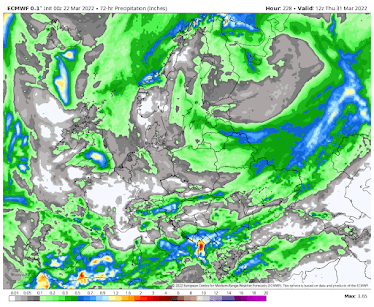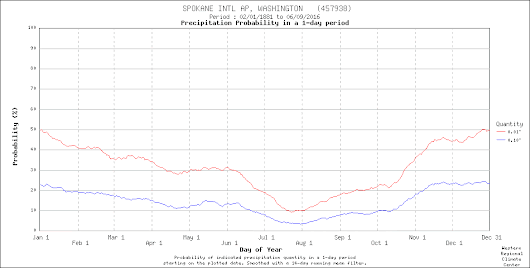During the past year or so, whenever there is a significant precipitation event on the West Coast, the media headlines "atmospheric rivers."
Ten years ago, hardly anyone talked about such rivers. Now, they are mentioned all the time!
To illustrate the change, here is the google trends analysis of searches on "atmospheric river" from 2004 to today. Before 2010, almost no one was searching for the term. But this November, it was very, very popular. The same thing is true of mentions in newspapers and online.
What has changed?
Several people have asked me whether atmospheric rivers are a new weather feature forced by global warming.
Others ask me whether global warming has made atmospheric rivers stronger and more frequent.
Well, it is time to "clear the air."
The phenomenon now known as atmospheric rivers is as old as the hills. They have NOT gotten stronger or more frequent on the U.S. West Coast, although they may in the future.
I should note that this topic is one I have published in the peer-reviewed literature and received Federal support (NSF) to study.
Atmospheric River 101
Atmospheric rivers are plumes of moisture (water vapor) that move into the midlatitudes from the tropics or subtropics. They can be best viewed through weather satellite imagery sensitive to water vapor in the vertical.
In the example below, the total amount of water vapor in a column is presented for a single time, with red and purple indicating the highest values, which generally are found in the tropics. This makes sense since warm air can "hold" more water vapor than cooler air. But look closely and you will see tendrils of water vapor extending into the midlatitudes.
These are atmospheric rivers and several are apparent at this time--which is NOT unusual.
The term "atmospheric river" was first used in a paper by Zhu and Newell in 1994, with the title "Atmospheric Rivers and Bombs." Bomb is a term used for rapidly developing mid-latitude cyclones.
They noted that rapidly developing low-pressure centers often have a filament of moisture associated with them. They called these filaments "atmospheric rivers" because they move large amounts of water vapor, the equivalent of major rivers such as the Mississippi and Amazon.
The term "atmospheric river" was evocative and catchy, and the name rapidly entered meteorological parlance and subsequently was picked up by the media.
The phenomenon of strong winds accompanied by large amounts of moisture was well known before 1994, but the names used, like the "low-level warm sector jet" were not destined to become household words. Wonder why.
To illustrate some previous use of the idea under a different name, below is an old USFS figure showing a midlatitude cyclone and fronts: I have added a red arrow to highlight the area of the strong, moist southwesterly flow that was described in the document.
Global satellite imagery showing moisture, which become available during the 1990s, provided impressive graphics of the phenomenon and helped in publicizing the feature.
But there was something else. The advent of high-resolution numerical weather prediction provided very graphic pictures of what happens when atmospheric rivers hit West Coast terrain: huge amounts of water vapor can be converted into precipitation as the strong winds and bountiful moisture of atmospheric rivers are forced to rise by coastal mountains.
To illustrate here is an example from December 2010. A long moisture plume (atmospheric river) moved from west of Hawaii to the Washington coast.
And the 24-h simulated precipitation was enormous: 5-10 inches in the mountains. Some atmospheric rivers have dropped twice that.
Atmospheric rivers provide substantial precipitation for the entire West Coast, from northern Mexico to southeast Alaska, with the percentage of annual precipitation associated with the rivers increasing to the south.
There is a deep literature and substantial observational evidence suggesting that during the past century there has NOT been a general upward trend in atmospheric river intensity and frequency on the West Coat..
In some locations, heavy precipitation is up and some places down. This was the conclusion of a peer-reviewed paper I published with Adam Skalenakis and Michael Warner (see graphic from the paper below, with arrows showing the long-term trends). A number of other papers have come to the same conclusion (no observed historical trend in West Coast atmospheric rivers). I will do another blog on observed heavy precipitation trends for the region and the future of atmospheric rivers.
Climate simulations do suggest a modest increase (10-20%) in atmospheric rivers by the end of this century if greenhouse gases continue to rise. That increase, coupled with less snowpack, could contribute to increased flooding, particularly after 2050.


.jpeg)










 or here.
or here.


































